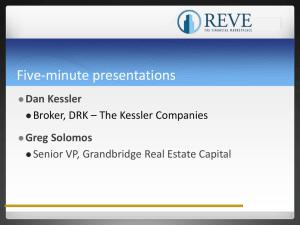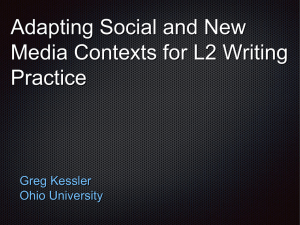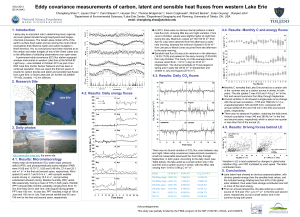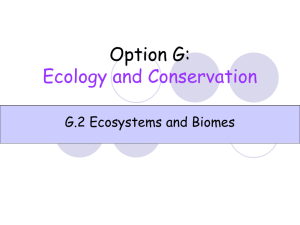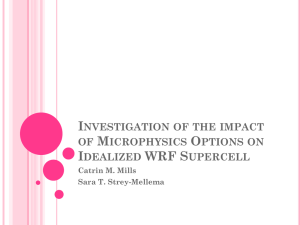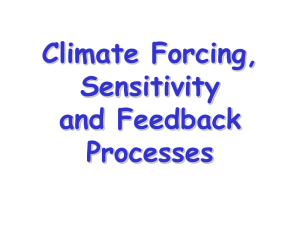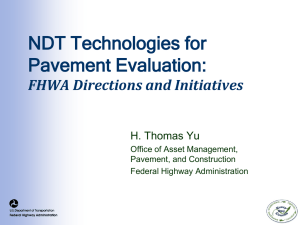hw5
advertisement
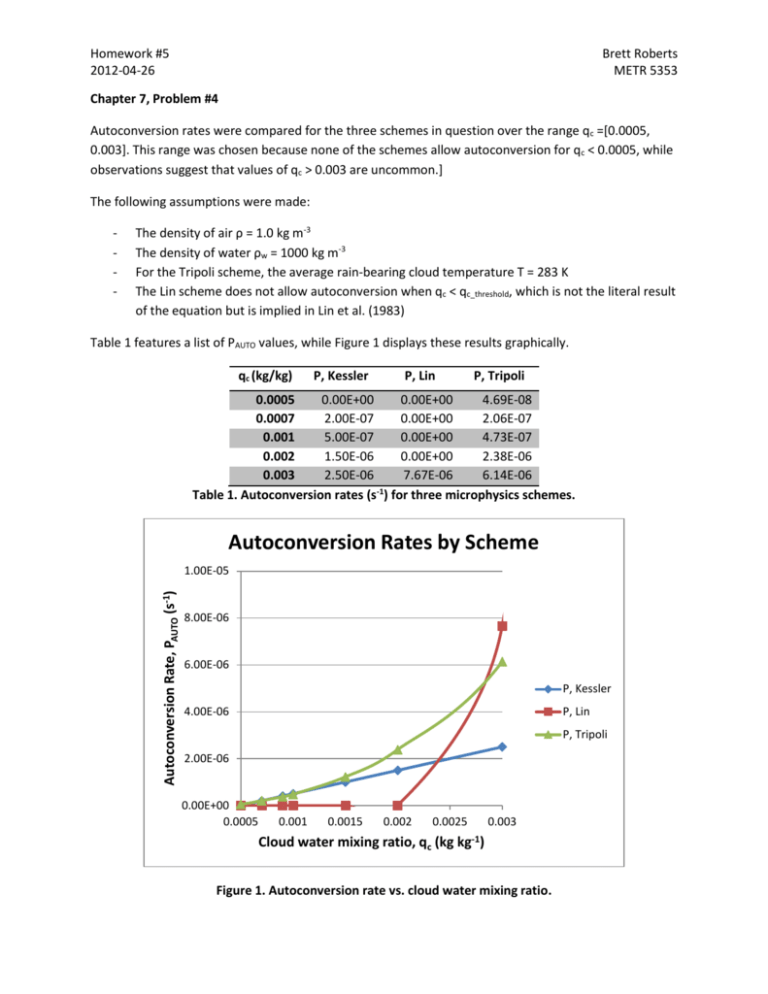
Homework #5 2012-04-26 Brett Roberts METR 5353 Chapter 7, Problem #4 Autoconversion rates were compared for the three schemes in question over the range qc =[0.0005, 0.003]. This range was chosen because none of the schemes allow autoconversion for qc < 0.0005, while observations suggest that values of qc > 0.003 are uncommon.] The following assumptions were made: - The density of air ρ = 1.0 kg m-3 The density of water ρw = 1000 kg m-3 For the Tripoli scheme, the average rain-bearing cloud temperature T = 283 K The Lin scheme does not allow autoconversion when qc < qc_threshold, which is not the literal result of the equation but is implied in Lin et al. (1983) Table 1 features a list of PAUTO values, while Figure 1 displays these results graphically. qc (kg/kg) P, Kessler P, Lin P, Tripoli 0.0005 0.00E+00 0.00E+00 4.69E-08 0.0007 2.00E-07 0.00E+00 2.06E-07 0.001 5.00E-07 0.00E+00 4.73E-07 0.002 1.50E-06 0.00E+00 2.38E-06 0.003 2.50E-06 7.67E-06 6.14E-06 -1 Table 1. Autoconversion rates (s ) for three microphysics schemes. Autoconversion Rates by Scheme Autoconversion Rate, PAUTO (s-1) 1.00E-05 8.00E-06 6.00E-06 P, Kessler 4.00E-06 P, Lin P, Tripoli 2.00E-06 0.00E+00 0.0005 0.001 0.0015 0.002 0.0025 Cloud water mixing ratio, qc (kg 0.003 kg-1) Figure 1. Autoconversion rate vs. cloud water mixing ratio. Homework #5 2012-04-26 Brett Roberts METR 5353 The Kessler and Tripoli calculations for autoconversion rate are relatively similar for low values of qc (qc < 0.002); for higher values, the Tripoli calculation becomes increasingly larger than Kessler. The Lin calculation behaves much differently, not activating at all until qc > 0.002. Above its threshold, however, it ramps up much more rapidly than the other two schemes. At qc = 0.003, the Tripoli scheme calculates PAUTO more than 100% larger than Kessler, while the Lin value is over 200% larger. Note that all calculations were performed using formulas in Microsoft Excel, owing to the number of calculations needed. (This applies to the remaining problems, as well). Chapter 7, Problem #6 Accretion rates were compared for the three schemes in question over the range qr = [0, 0.01]. Numerous assumptions were made in this assessment: - For the Kessler scheme, the collection efficiency E = 1 in all cases For all schemes, the cloud water mixing ratio qc = 0.002 was chosen arbitrarily, since none was specified The density of air ρ = 1.0 kg m-3 The density of water ρw = 1000 kg m-3 The rain intercept parameter n0r = 8x106 m-4, per Marshall and Palmer (1948). Table 2 features a list of PACCR values, while Figure 2 displays these values graphically. With all else constant, these three schemes increase accretion linearly with rain water mixing ratio; the only difference in their behaviors is the rate of increase (slope). The Schultz scheme has the highest slope, followed by Tripoli, with Kessler the slowest-increasing. Therefore, the larger qr becomes, the more difference is found between the three schemes. qr (kg/kg) P, Kessler P, Tripoli P, Schultz 0.0001 1.04E-06 1.07E-06 3.40E-06 0.0003 2.95E-06 3.20E-06 1.02E-05 0.0005 4.78E-06 5.33E-06 1.70E-05 0.0007 6.59E-06 7.46E-06 2.38E-05 0.001 9.24E-06 1.07E-05 3.40E-05 0.0015 1.36E-05 1.60E-05 5.10E-05 0.002 1.79E-05 2.13E-05 6.80E-05 0.003 2.62E-05 3.20E-05 1.02E-04 0.005 4.26E-05 5.33E-05 1.70E-04 0.01 8.24E-05 1.07E-04 3.40E-04 -1 Table 2. Accretion rates (s ) for three microphysics schemes. Homework #5 2012-04-26 Brett Roberts METR 5353 Accretion Rates by Scheme 4.00E-04 Accretion Rate, PACCR (s-1) 3.50E-04 3.00E-04 2.50E-04 2.00E-04 P, Kessler P, Tripoli 1.50E-04 P, Schultz 1.00E-04 5.00E-05 0.00E+00 0 0.002 0.004 0.006 0.008 0.01 Rain water mixing ratio, qr (kg kg-1) Figure 2. Accretion rate vs. rain water mixing ratio. Chapter 9, Problem #2 Downwelling longwave radiation was calculated using the method proposed by Harshvardham and Weinman (1982). The cloud fraction b was varied from 0.2 to 1, while the cloud aspect ratio a was varied from 1 to 5. The results are tabulated in Table 3. b 0.2 0.4 0.6 0.8 1 330.17 334.6491 337.4776 339.426 340.8497 338.6364 342.2107 344.0745 345.2186 345.9924 343.9341 346.1283 347.1568 347.7535 348.1432 347.4928 348.4729 348.9021 349.143 349.2972 350 350 350 350 350 a 1 2 3 4 5 Table 3. Downwelling radiation (W m-2) for varying cloud conditions. The results indicate that cloud aspect ratio is most critical when cloud cover is relatively low (but nonzero, of course). The deviation from cloudy-sky conditions (FD = 350 W m-2) at b = 0.2 over the range a = [1,5] varies by about 100% (~341 W m-2 vs. ~330 W m-2). Homework #5 2012-04-26 Brett Roberts METR 5353 Chapter 9, Problem #3 Linear interpolation of the results in Table 3 suggests that an error in b of 30%, with a range of b = [0.2,0.5], may result in an error of ~10 W m-2 in FD. If the 30% error is centered around a higher cloudcover value, covering the range b = [0.7,1], then the resultant radiation error is reduced to ~2 W m-2. This is, of course, dependent upon the FD-clear and FD-cloudy values assumed for this problem. The worst-case error of 10 W m-2 is certainly a noteworthy error in the radiation budget, though it is not likely to be catastrophic for the model, given that it’s one to two orders of magnitude smaller than the radiation terms themselves (e.g., FD ~ 350 W m-2). On the first exam, it was found that a constant 50 W m-2 error in the radiation budget resulted in a mixed-layer temperature error of ~2 K by the end of a day. Given that our 30% cloud-cover error is unlikely to persist throughout an entire diurnal cycle, and that its error in the radiation budget is only ~10 W m-2, the effect upon boundary-layer temperature is unlikely to be particularly noteworthy.
